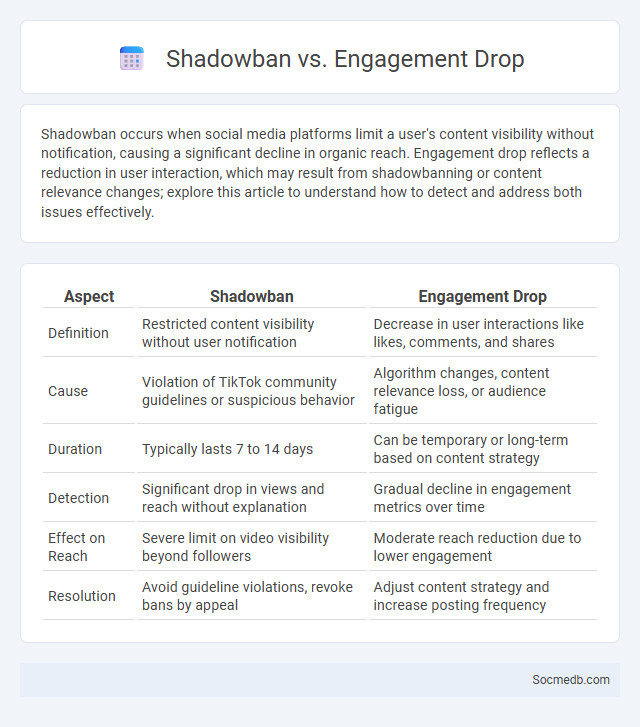
Photo illustration: Shadowban vs Engagement Drop
Shadowban occurs when social media platforms limit a user's content visibility without notification, causing a significant decline in organic reach. Engagement drop reflects a reduction in user interaction, which may result from shadowbanning or content relevance changes; explore this article to understand how to detect and address both issues effectively.
Table of Comparison
| Aspect | Shadowban | Engagement Drop |
|---|---|---|
| Definition | Restricted content visibility without user notification | Decrease in user interactions like likes, comments, and shares |
| Cause | Violation of TikTok community guidelines or suspicious behavior | Algorithm changes, content relevance loss, or audience fatigue |
| Duration | Typically lasts 7 to 14 days | Can be temporary or long-term based on content strategy |
| Detection | Significant drop in views and reach without explanation | Gradual decline in engagement metrics over time |
| Effect on Reach | Severe limit on video visibility beyond followers | Moderate reach reduction due to lower engagement |
| Resolution | Avoid guideline violations, revoke bans by appeal | Adjust content strategy and increase posting frequency |
Understanding Shadowbanning: Definition and Mechanisms
Shadowbanning is a covert moderation technique used on social media platforms like Instagram, Twitter, and TikTok to restrict a user's content visibility without their knowledge. The mechanism involves limiting reach, demoting posts in feeds, or removing content from search results and hashtags, effectively reducing engagement and audience exposure. This approach aims to curb spam, misinformation, and harmful behavior while avoiding direct confrontation with users.
What is a Shadowban? Signs and Symptoms
A shadowban on social media restricts your content visibility without notifying you, causing a significant drop in engagement such as likes, comments, and follower growth. Signs and symptoms include a sudden decline in reach, friends or followers not seeing your posts, and hashtags failing to attract views. You may notice your posts no longer appear in hashtag searches or on follower timelines despite regular activity.
Engagement Drops: Natural Declines vs Platform Action
Engagement drops on social media can stem from natural declines, such as audience fatigue or content saturation, as well as from platform actions like algorithm changes or policy enforcement. These fluctuations significantly impact reach and interaction metrics across sites like Instagram, Facebook, and TikTok. Understanding the distinction between organic engagement shifts and those triggered by platform modifications is essential for optimizing content strategy and maintaining audience connection.
Shadowban vs Engagement Drop: Key Differences
Shadowban restricts the visibility of Your social media content without notification, causing a significant and often sudden drop in reach, while engagement drop refers to a natural decline in likes, comments, and shares due to changing audience behavior or content relevance. Shadowbans are typically imposed by platform algorithms for policy violations or spamming, making Your posts invisible to followers and hashtag searches, whereas engagement drops result from decreased follower interest or content saturation. Understanding these differences helps You identify whether Your account faces algorithmic penalties or simply experiences fluctuating user interaction patterns.
Common Causes of Shadowbanning
Shadowbanning on social media often results from excessive use of hashtags, posting repetitive content, or violating community guidelines related to spam or inappropriate behavior. Algorithms detect suspicious activity like mass following/unfollowing, automated actions from bots, or sharing misleading information, triggering restricted visibility. User reports and frequent content flagged for misinformation or harassment significantly increase the likelihood of shadowbanning across platforms like Instagram, Twitter, and TikTok.
Metrics to Identify Shadowbanning vs Engagement Drop
Shadowbanning on social media platforms often results in a sudden and significant drop in reach and impressions while follower counts remain stable, signaling restricted content visibility by the platform's algorithm. Engagement drop, in contrast, typically reflects a gradual decrease in likes, comments, and shares correlated with audience interest or content quality without a sharp decline in reach metrics. Key metrics to differentiate include consistent follower activity paired with declining reach for shadowbanning, versus concurrent declines across reach, engagement, and follower interaction for organic engagement drop.
Social Media Algorithms: How They Influence Visibility
Social media algorithms prioritize content based on user engagement, relevance, and behavior patterns to maximize platform retention and ad revenue. These algorithms analyze data points such as likes, shares, comments, and viewing time to determine the visibility of posts within users' feeds. Understanding the mechanics of algorithm-driven content distribution is essential for optimizing social media marketing strategies and increasing organic reach.
How to Recover from a Shadowban
Recovering from a social media shadowban involves identifying the cause, such as violating community guidelines or using banned hashtags, and promptly removing any offending content. You should reduce posting frequency and engage authentically with your audience to rebuild trust and signals to the platform's algorithm. Monitoring analytics and avoiding repeated violations can help restore visibility and get your account back in good standing.
Preventing Engagement Drops and Shadowbanning
Consistent posting schedules and authentic interactions help prevent drastic drops in engagement on platforms like Instagram and TikTok. Understanding platform algorithms, avoiding spammy behaviors, and using varied content formats reduce the risk of shadowbanning, which limits your visibility without notification. You can maintain steady growth by monitoring analytics and adapting your strategy based on audience feedback.
Shadowbanning Myths: Debunking Common Misconceptions
Shadowbanning myths often lead users to believe their content is deliberately hidden or suppressed without explanation, but most platforms rely on algorithms rather than secret bans. Your visibility is generally influenced by engagement, relevance, and content compliance with community guidelines, not covert restrictions. Understanding these factors helps clarify that perceived shadowbanning usually results from reduced interaction or algorithmic adjustments, not deliberate censorship.
 socmedb.com
socmedb.com